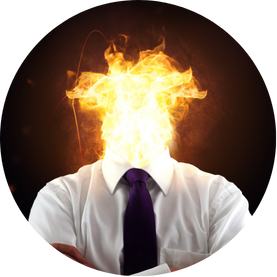Imagine the next generation of offices: silent, light-controlled, with real-time biofeedback on your wrist. Your workspace adapts to your internal tension – before the neck locks up, before the migraine sets in, before back pain disrupts the flow. Until we get there, we must learn to read our body's early warning system ourselves. Stress-related pain is not a defect, but a precise alarm signal. Those who understand it protect their performance, health, and longevity.
Stress activates the sympathetic nervous system, increases muscle tone, and prepares the body for action. This is useful in the short term. However, if tension remains high, muscular triggers solidify, and the pain system becomes sensitized. This phenomenon is called Central Sensitizationthe nervous system reacts excessively to stimuli. Commonly affected areas include the neck, jaw, shoulders, back, and pelvic floor. Psychological factors such as Catastrophizingexaggerated thinking of threat and pain also enhance perception. Noise, lack of sleep, and constant availability act as stress amplifiers. In short: stress pain is a systemic phenomenon – body, brain, and environment work together.
Unchecked stress increases pain intensity, disrupts sleep, and diminishes quality of life – and thus focus, creativity, and recovery. A study on chronic noise exposure in the workplace showed that employees with sustained exposure to low-frequency noise reported higher pain levels, as well as more anxiety and depression symptoms, and limited physical functions compared to those with low exposure [1]. This combination of increased tension, poorer sleep, and negative mood drives a feedback loop that stabilizes pain. Conversely, targeted relaxation training lowers physiological arousal, reduces muscle tension, and thus pain – a lever with direct performance benefits in everyday life.
Mindfulness-Based Stress Reduction (MBSR) has been shown in a randomized controlled trial with chronic pain patients to reduce pain intensity and interference with mood, work, and sleep more than usual treatment; after 6 and 13 months, participants also benefited in terms of quality of life – an indication of sustainable effects on pain experiences and functionality [2]. Progressive Muscle Relaxation (PMR) reduced pain, muscle stiffness, sleep disturbances, anxiety, and fatigue in clinical settings; measurable decreases in respiratory rate and blood pressure were also observed – clear physiological markers for stress system relief [3]. In fibromyalgia, PMR led to significant reductions in pain, fatigue, perceived stress, blood pressure, and pulse compared to conventional therapy, further supporting the stress-pain connection [4]. Cognitive Behavioral Therapy (CBT) shows moderate improvements in meta-analyses for catastrophizing thoughts, movement anxiety, and anxiety disorders – factors that fuel central sensitization and thereby increase pain intensity. Interestingly, CBT is effective regardless of whether it is conducted online or in person, group or individual-based; led by professionals, catastrophizing decreases more significantly [5]. Scalable, home-based CBT approaches are being developed for therapy-resistant chronic pain syndromes to enhance self-management and reach [6]. Taken together, the data paints a consistent picture: when interventions target tension, attention, and thought patterns, pain and stress decrease – and objective vital parameters move towards recovery.
- Breath Focus 4-6: Inhale for 4 seconds, exhale for 6 seconds, for 5 minutes, 2–3 times daily. Goal: vagus activation, reduction in heart rate and muscle tone. Can be applied acutely during moments of stress. Meditation and breathing techniques reduce stress symptoms and physical tension, especially with regular practice [7] [8] [9].
- Micro-Meditation in Workflow: Set a 3-minute reset every 90 minutes: close your eyes, scan your body, extend your breathing. Practice formal meditation (sitting meditation or body scan) for 10–15 minutes daily. More practice time correlates with greater improvements in stress, symptoms, and well-being [9].
- MBSR as an 8-week framework: Book an evidence-based program or use a high-quality app in a group format. Target markers: less pain interference with work, mood, and sleep; initial effects after 6 weeks, stable after 3–6 months [2].
- PMR Routine (10–15 minutes): Sequentially tense feet, calves, thighs, buttocks, abdomen, back, hands, forearms, upper arms, shoulders, neck, and face for 5–7 seconds, then relax for 10–15 seconds; 1–2 rounds daily. Proven to reduce pain, muscle stiffness, sleep disturbances, and fatigue [3] [4].
- CBT Self-Coaching: Recognize catastrophizing (“It will only get worse”) and replace it with functional thoughts (“I have tools: breathing, PMR, breaks – the tension will ease”). Complement with gradual movement exposure to reduce movement anxiety. CBT reduces unhelpful thinking and anxiety – also well implemented digitally [5] [6].
- Noise Hygiene: Identify low-frequency sources (air conditioning, machines, traffic hum). Use earplugs/noise-canceling, take a 5-minute noise-free break every 90 minutes, and move deep work to quieter areas. Continuous noise increases pain and stress levels – breaks are prevention [1].
Stress-related pain is a learnable signal – those who train their breath, attention, muscles, and thoughts reduce pain and regain energy. Start today: 5 minutes of 4-6 breathing, an evening PMR session, planning MBSR or CBT in 2 weeks. Your nervous system will respond with less pain and more performance.
This health article was created with AI support and is intended to help people access current scientific health knowledge. It contributes to the democratization of science – however, it does not replace professional medical advice and may present individual details in a simplified or slightly inaccurate manner due to AI-generated content. HEARTPORT and its affiliates assume no liability for the accuracy, completeness, or applicability of the information provided.













